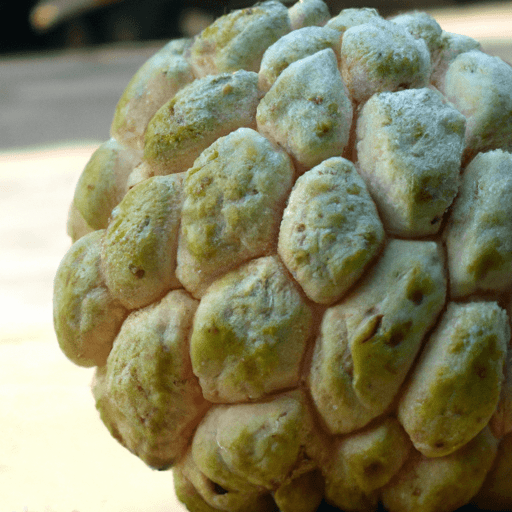A Delicious and Exotic Delight: Exploring the Cherimoya
If you are on the lookout for a unique and tantalizing fruit to add to your culinary repertoire, look no further than the cherimoya. With its creamy texture, tropical flavor, and interesting history, the cherimoya is sure to captivate your taste buds and fill your kitchen with exotic aromas. Let’s dive into the world of this delectable fruit and discover its culinary wonders!
Taste and Texture
Often hailed as the “custard apple,” the cherimoya possesses a soft, creamy, and custard-like texture. When you take a spoonful of the flesh, it melts in your mouth, leaving a delightful richness behind. The flavor is a harmonious blend of tropical notes, combining hints of pineapple, coconut, strawberry, and banana, with a touch of citrus. This unique flavor profile beautifully balances sweetness with a subtle tartness, making it a perfect addition to various culinary creations.
Common Uses in Cooking
The cherimoya’s luscious flavor and velvety texture lend themselves well to both sweet and savory preparations. Here are a few delightful ways you can incorporate this exotic fruit into your cooking:
1. Enjoy It Fresh:
The simplest and most rewarding way to enjoy a cherimoya is to eat it fresh. Simply slice it in half, scoop out the flesh, and relish the tropical delight. You can also use a spoon to scoop out the pulp and enjoy it as a standalone dessert or blend it with other fruits to create a refreshing smoothie.
2. Desserts and Baked Goods:
The cherimoya can be the star ingredient in a variety of desserts. Whip up a velvety cherimoya mousse, create a tropical fruit tart, or infuse the fruit’s flavor into custards, puddings, and ice creams. Its fragrant and sweet taste is also a fantastic addition to cakes, muffins, and pies, especially when combined with coconut or citrus flavors.
3. Savory Dishes:
Although commonly associated with sweet creations, cherimoya can be a surprising addition to savory dishes as well. Its delicate and tropical flavor can complement seafood dishes like ceviche or shrimp salad. It also pairs well with poultry, adding a touch of sweetness to roasted chicken or grilled turkey.
Nutritional Value and Health Benefits
Beyond its delightful taste, the cherimoya is packed with essential nutrients and health benefits. Here’s a quick rundown of what this exotic fruit has to offer:
Vitamin C Boost: Cherimoya is an excellent source of vitamin C, providing a significant portion of your recommended daily intake. This powerful antioxidant plays a crucial role in supporting a healthy immune system and promoting overall well-being.
Dietary Fiber: With its fiber content, cherimoya helps promote healthy digestion and can contribute to maintaining a healthy weight.
B Vitamins: This fruit contains various B vitamins, including vitamin B6, which plays a crucial role in brain development and function, as well as energy production.
Mineral Rich: Cherimoya is a good source of several minerals, such as potassium, magnesium, and manganese. These minerals are important for maintaining healthy bones, regulating blood pressure, and supporting various metabolic processes in the body.
History and Fun Facts
The cherimoya is native to the Andean valleys of South America and has a rich history dating back centuries. It was highly valued by the Incas, who called it “the fruit of the gods.” Eventually, it made its way to Europe during the colonial era and found popularity among tropical fruit enthusiasts.
Interestingly, the cherimoya tree is related to the soursop and sugar apple trees. Their botanical similarities explain the cherimoya’s custard-like texture, reminiscent of its close cousins.
Conclusion
The cherimoya is a true gem in the culinary world, offering an explosion of tropical flavors and a delightful creamy texture. Whether enjoyed fresh, incorporated into desserts, or used in savory dishes, this exotic fruit always manages to leave a lasting impression. So why not embark on a culinary adventure and experience the joy of cherimoya for yourself? Your taste buds will thank you!
Cherimoya
Origin: Cherimoya, also known as “custard apple,” is a fruit that originated in the Andes mountains of South America. Specifically, it is believed to have originated in the high-altitude regions of Peru, Ecuador, and Colombia.
Common Uses: Cherimoya is commonly used as a fresh fruit and is enjoyed eaten raw. The fruit has a unique creamy texture and sweet flavor, often described as a combination of banana, pineapple, and strawberry. It is consumed by simply scooping out the flesh with a spoon or used in various dessert preparations like ice creams, smoothies, and sherbets. It is also sometimes used to flavor beverages, jams, and pastries.
Nutritional Benefits: Cherimoya is a good source of several essential nutrients. It is rich in Vitamin C, providing about 62% of the recommended daily intake per serving. It also contains dietary fiber, potassium, magnesium, and Vitamin B6. It is a low-calorie fruit, making it a good addition to a balanced diet.
Unique Properties: Cherimoya is known for its unique appearance and texture. It has a green, scaly, and bumpy skin, which is not edible. The creamy white flesh inside is divided into segments, each containing a black seed. Its flavor and texture make it a popular fruit choice, especially for those who enjoy custard-like textures.
Historical Significance: Cherimoya had cultural significance in several indigenous civilizations of South America. It was highly revered by the Incas and other indigenous groups who considered it as the “fruit of the gods.” Cherimoya was believed to have both medicinal and spiritual properties and was used in various rituals and celebrations. Today, it continues to be an important fruit in South American cuisine and is cultivated in several regions around the world.




Use the share button below if you liked it.
It makes me smile, when I see it.